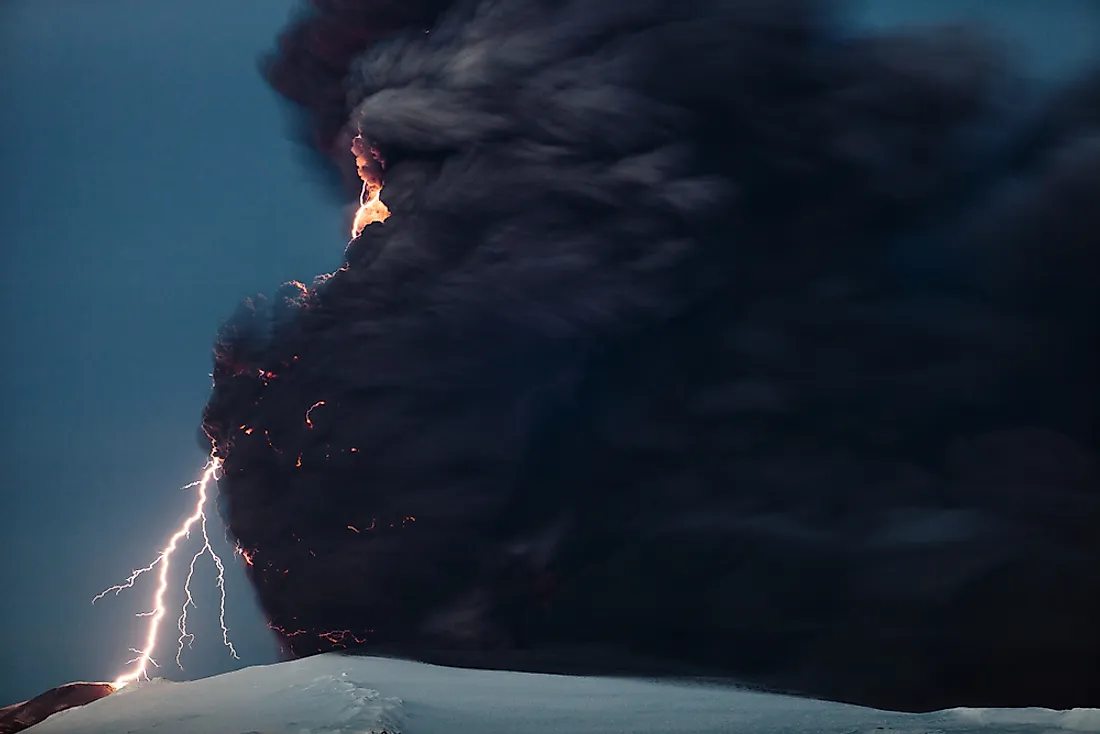What Causes Volcanic Lightning?

Volcanic lightning is an electrical discharge caused by volcanic eruptions. It often occurs during the early stages of an eruption. Volcanic eruptions are sometimes referred to as "dirty thunderstorms" because of ice formation and moist convention that drives the eruption-plume dynamic, which ultimately triggers volcanic lightning. Unlike a typical thunderstorm, volcanic eruptions can generate a bolt of lightning before ice crystals are created in the ash clouds. The earliest recorded observation of volcanic lightning occurred in 79 AD, when Gaius Plinius Caecilius Secundus, who was known as Pliny the Younger, described the eruption of Mount Vesuvius. However, volcanic lightning was not studied until the nineteenth century, when Professor Palmieri observed volcanic eruptions of Mount Vesuvius in 1872, 1868, 1861, and 1858, which often included volcanic lightning, at the Vesuvius Observatory.
Causes
Volcanic lightning is not formed deep in the Earth’s Crust, but rather in the volcanic plume. Volcanic lightning occurs during the active phase of an eruption and is more frequent in eruptions with large ash plumes, in which the lava produces significant temperature gradients. When lava reaches the surface, it erupts through weak points. Additionally, when a volcano erupts, lava is usually accompanied by a considerable amount of ash and soot. Occasionally, if particles are charged, lightning is generated.
Scientists have identified two phases of volcanic lightning production during an intense eruption. The first stage, referred to as the eruptive phase, represents volcanic lightning that occurs immediately after a crater erupts. The eruptive phase of lightning is believed to be caused by ejected particles that are positively charged. The second stage, named the plume phase, refers to lightning formed in the ash plume, which is caused by fragmenting and colliding volcanic ash particles that create static electricity. Volcanic ash particles are usually charged, and collisions result in charge separation. Various processes, including aerodynamic sorting, can separate negatively and positively charged particles, resulting in some parts of a cloud becoming more positively or negatively charged than others. Once charge separation has become too intense, electricity flows between the negatively and positively charged parts of the cloud, creating lightning that neutralizes the charge separation. Intense lightning storms can be generated during large volcanic eruptions.
Charging Mechanisms
Ice Charging
Ice charging plays a key function in various kinds of eruption plumes, especially those involving magma-water interaction or plumes that rise above the freezing point. Ice charging is the dirty thunderstorm mechanism of electrification of the volcanic plume. A thunderstorm normally generates lightning via ice charging as the cloud is electrified by other hydrometeors and colliding ice crystals. Plumes have abundant water, which they source from magma. Water is vaporized from surrounding glaciers and lakes, and then entrained as the volcanic plume erupts into the atmosphere. The water vapor condenses into liquid while it rises to the atmosphere. If the temperature of the plume drops below the freezing point, the liquid freezes and becomes ice. Lightning activity increases significantly after the volcanic plume rises above the freezing level. Ice crystals at the top of a volcanic cloud are charge carriers.
Frictional Charging
The primary electrical charging mechanism within a volcanic plume during an eruption is believed to the frictional (Triboelectric) charging. An electrical charge is generated when ash, ice particles and rock fragments in the volcanic plume collide and produce static electricity, which is similar to the way ice particles collide in a thunderstorm. Convective activities that cause a volcanic plume to rise and electric charge separation in a cloud also cause an electrical breakdown.
Radioactive Charging
While its effect is believed to have a minimal impact on volcanic plume charging, the radioisotopes within ejected rocks may influence particle charging. A study conducted on the ash particles from the eruptions of Grimsovtn and Eyjafjallajökull, both of which are volcanoes in Iceland, confirmed the presence of naturally occurring radioactivity. Radioisotopes found in the particles from the Eyjafjallajökull plume were an unlikely source of particle charging. However, there was greater potential for self-charging near the volcano’s vent, where large particles were found.
Factors That Affect the Formation of Volcanic Lightning
Height of Volcanic Plume
The height of a volcano's ash plume is directly related to a mechanism that produces volcanic lightning. In shorter ash plumes (less than 2.49 mi), a considerable percentage of particles get their charge from the fragmentation process of the rocks near the volcano’s vent, which is a process known as fractoemission. The high water vapor concentration in taller ash plums (between 4.35 mi and 7.46 mi) contributes to lightning activity.
Atmospheric Temperature
Atmospheric temperature plays an important role in the generation of volcanic lightning. Extremely cold temperatures help condense water vapor in a volcano plume before freezing the water particles into ice. Cold temperature also promotes ice charging, which results in more electrical activity.
Lightning-Induced Volcanic-Spherules (LIVS)
Investigations and experimental studies of volcanic deposits have confirmed that volcanic lightning produces a by-product known as lightning-induced volcanic spherules (LIVS). Small glass spherules are formed during high-temperature processes, including cloud-to-ground lightning strikes. The temperature of a lightning bolt can exceed 30,000 °C, and when a lightning bolt hits the ash particles in the volcanic plume, one of two things can happen. The bolt of lightning can either vaporize the ash completely or melt the ash, which solidifies as it cools and form orb shapes. The presence of LIVS serves as geological evidence of volcanic lightning, even if it was not directly observed.











